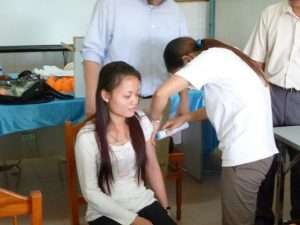Jabs Without Needles?
A needle-free injection device is trialled in Cambodia

Julian Bilous/Bill & Melinda Gates Foundation
It has long been clear that, as the world moves closer to the eradication of polio, there will eventually need to be a switch from the widespread use of oral polio vaccine (OPV) to an inactivated polio vaccine (IPV) – an injectable vaccine. However, delivering injections in places with under-resourced health systems and undertrained health workers can be difficult and hazardous. Luckily, a needle-free injection device recently trialled in Cambodia is, so far, proving safe and easy to use.
In simple terms, the disposable syringe jet injector (DSJI) uses high pressure to push the vaccine through the skin. Cambodian health workers quickly took to the new technology at training sessions in the lead-up to a measles vaccination campaign in November. By the end of the first day of training, the group of experienced vaccinators, who had never seen a DSJI before, had become familiar with the jet injector, had practised on rubber balls and then injected each other with sterile saline. The team then took to the field, vaccinating children in underserved villages in Koh Thom (around 50km south of Phnom Penh), using the DSJI under the supervision of a team of consultants and international staff trained in the device’s use.
The use of syringes to deliver vaccines can carry significant risks in areas where health facilities are under-resourced and health workers have received little or poor training. Risks include disposable syringes being used for more than one patient, of improper use leading to injury, of accidental needle-stick injuries and inadequate disposal. Because the DSJI device is needle-free, these risks are avoided.
It is hoped that this technology may be used to deliver IPV in the future. At the moment, OPV is the preferred vaccine for use in mass polio vaccination campaigns, as it effectively stops polio transmission in communities, it is relatively cheap (a dose can cost as little as 11 cents) and, because it comes in the form of drops, it can be administered orally by anyone. However, in extremely rare instances, the weakened virus in OPV can mutate and regain the ability to cause paralysis. When the risk of vaccine-derived poliovirus begins to equal the risk of wild poliovirus (as wild poliovirus dies out), it is expected that countries will switch to using IPV. Making IPV easier to use and affordable is therefore a critical goal of the Global Polio Eradication Initiative (GPEI).
Even beyond its use for polio vaccine, the DSJI could be used to provide many other vaccines, providing a safer way to ensure that children around the world are protected against easily preventable diseases. Resources from polio and measles programmes are being used to find safer alternatives to regular syringes, with benefits for vaccination as a whole.












